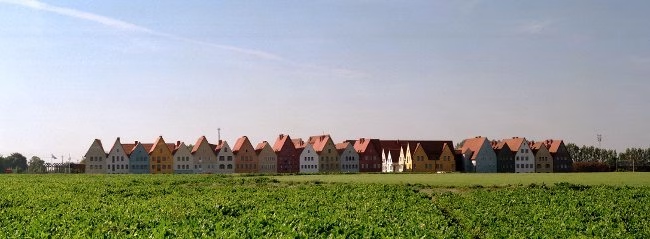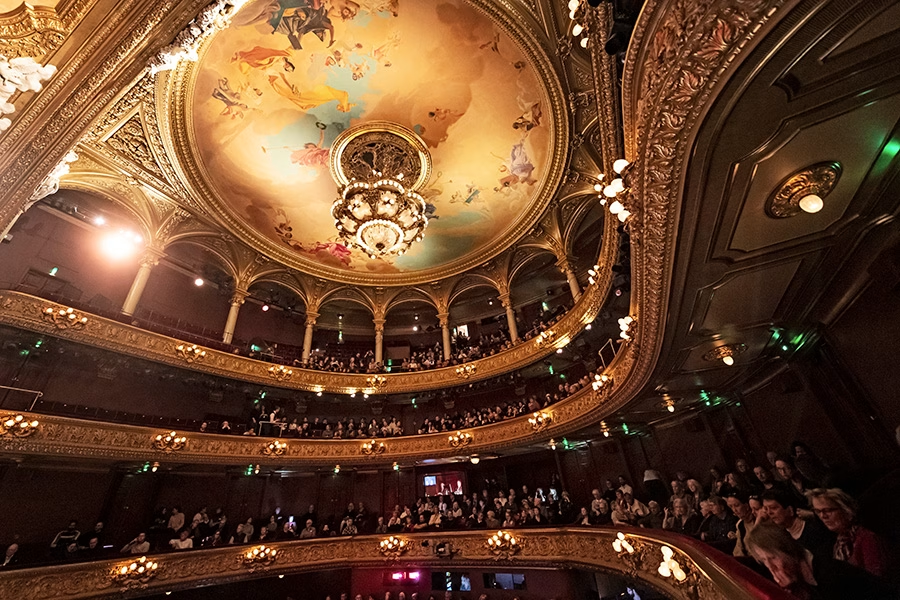When it comes to the aim of capturing the spirit of the times, there is probably no profession that can compare with architects. A building that represents a true expression of its time enjoys the highest status a building can achieve among the fellowship of architects. It does not matter whether the building is ugly or beautiful, whether it is beloved by the people or not; what matters is the connection between the building and the putative spirit of the times. Because society is always changing, the architecture of buildings must change; indeed they should be on the cutting edge and, as it were, a forerunner of the new.
The journalist Anders Frelin (DN 17 Apri 2009) describes below what can happen when a newly constructed and fairly uninteresting building is forced on a neighbourhood with old buildings:
Just after the bridge from Hornstull to Liljeholmen [in Stockholm] is a new building that makes one recoil. It follows the older buildings abutting it with its form. But with its black facade and its big plates of glass, the building is a clear representative of our times.
“There has to be sun, otherwise it will look like Eastern bloc architecture.”
The person saying that is the architect himself, Stefan Sjöberg from the architectural firm of Kjellander Sjöberg arkitektkontor, who designed a building in Liljeholmen in Stockholm that has been squeezed between two older buildings.
East bloc architecture or not, during the building permit application period, when people can submit their views on a project, the neighbouring housing cooperatives complained that the building looked too modern. However, the Stockholm City Planning Office wrote that the “building’s design can advantageously be given a modern expression in order not to compete with the neighbouring buildings.”
That was also the architects’ intent from the beginning: getting the building to fit in yet still give it an artistic form for our time.
The quote illustrates how deeply engrained this idea is of architecture as a representative of the times. It is something taken for granted by the journalist, the architect and the people at the city planning office.
In some professions, the idea of expressing the spirit of the times is so deeply rooted that it can be described as axiomatic, a natural assumption that need not be substantiated or explained. So it is difficult to hold a discussion about how reasonable, contradictory and ridiculous this assumption is of representing the spirit of the times.
The building in Liljeholmen itself cannot reasonably be described as a true architectural expression of our times. It is a rather traditional building in the modernist tradition, which has been around for 90 years. Modernism (in architecture and city planning) is not the same thing as modern. Modern is what is relevant right now, modernism is an architectural tradition that was most relevant in the early 20th century, when the global focus was on the second industrial revolution. What is possibly new here, and what probably inspired the journalist to write, is the contrast in styles between the existing buildings and the new one. In Stockholm, we have not had the custom of allowing too sharp a contrast in a neighbourhood.
I have nothing against the mixture as such; what I object to is that the journalist, the architect and the city planning office describe the house as “modern” in the sense of “a representative of our times,” and thus veil the discussion of what that really looks like. It is, in fact, a rather mediocre building with many anti-urban features. The main entry, which in a city should be facing the street, has been set to face the courtyard. The building also has gallery-style entries on the upper floors via a balcony that stretches the length of the building, which many surveys of people’s preference have shown to be highly unattractive.
On the ground floor, the building is set back relative to the other buildings, which reduces the exposure of its shop windows. They are also designed to be seen as little as possible (one could almost call it stealth architecture). The whole idea of shop windows is to attract customers and give the street an appealing atmosphere. This type of architecture is basically at home with the traditions of the 1960s; perhaps the emphasis on horizontal lines could be attributed to the 1970s (or 1930s). The only thing that distinguishes it from that era is the big windows.
This lack of feeling for what is urban is not in the least modern; it has been a characteristic of the modernist tradition for the entire 20th century.
The building in Liljeholmen no doubt makes a fine picture if it is photographed at night with light coming from the windows, but for pedestrians during the day time, it is decidedly unattractive. In the modernist tradition, architects have always had a bird’s eye view of architecture, and the fact that the residential areas constructed during Sweden’s Million Programme (in which a million housing units were built in the 1960s and 1970s) that were most heavily criticised can look pretty nice from a distance on a sunny day. Modernism is photogenic and – with its desire to shock – extremely well adapted to the media. Nonetheless, it shows very little regard for typical human needs.
How did we wind up here? How has the architectural profession, despite its eagerness to be with the times, completely lost contact with them? Why are architects so afraid of designing buildings that are graceful, attractive and harmonious? Why are they so afraid of discussing the psychological, social and economic consequences of architecture and urban planning? Why are they so afraid of repeating a recipe that works well?
It is a long but not particularly complicated story. It says rather a lot about the 20th century because urban planners and architects constituted an important part of the progressive and large-scale building in society.
The historian of science Thomas P. Hughes usually talks about the second discovery of America. The first was in the 15th century and the second in the 20th century, when Europe observed how the new production technology in the US, based on the assembly line, was totally superior to the existing production system. This second industrial revolution astounded the world. Cultural Europe still looked at the US as a nation with deep scepticism, but it embraced the new technology and tried to apply Fordism and Taylorism in every field possible.
Rapid urbanisation and the need to rebuild our cities came to give architects and sociologists considerable influence, and they, like many others, drew their ideas from the auto industry in particular. The automobile and the organisation of the auto industry were the key to the new city. Cars overcame distances. The city no longer needed to be densely built and mixed-use but could instead spread out into special districts: for example, residential, commercial and industrial zones.
Architects like Le Corbusier, Walter Gropius and Mies van der Rohe came to see themselves more as industrialists than architects. Gropius and Le Corbusier coined the expression Wohnford (the residential equivalent of the Model-T) to illustrate what they were after: assembly line production of housing.
How architects around the world came to draw their aesthetic inspiration from manufacturing is described with great precision in Mauro F Guillén’s book The Taylorized Beauty of the Mechanical. He writes in the introduction:
“Modernist architecture is the child of industry and engineering. Its rise during the early twentieth century dovetailed with the spread of scientific management, historically the most controversial and influential approach to the organization of work.”
Twentieth–century modernism in architecture simply became part of the industrial project, whose main message was large-scaleness, order, systems and control and whose leading figures were experts. It was when architects took on the role of expert that they developed the bad habit of ignoring the taste of regular people.
We saw the results of this development in thinking on a large scale when the Million Programme was introduced. In that era, architects were heroes, builders of societies who would change the world. When the Million Programme and the social structure they represented eventually crashed, architects needed to quickly re-evaluate their role. The profession came to distance itself from the role of architect role as social builder. The only thing left was aesthetics. Architects, who once stood for “the new society,” now simply stood for “new.” Ever since the 1960s, when this repositioning took place, the architectural profession has gradually reduced its interest in the role of influencing society and has instead cultivated a kind of cult of the new.
Architecture has become whatever is new.
However, the definition of what is new is rigid. It is only whatever fits the industrial aesthetic that is defined as new. This aesthetic has been a symbol of the future for so long that we have a hard time finding any other symbol. When we watch sci-fi films or see examples of future environments, it is always the same old Star Trek design that is used. The image of the future is extremely conservative.
Architects are thus serving new variants on the old industrial aesthetic to the media – which is really their own target group. Buildings should still be as big and tall as possible.
The reason often given now for this large-scale approach is the need for density and urbanity, which is rather comical. In the early stages of modernism, the reason for large-scale production was economic efficiency and the desire to bring order to small-scale, clustered cities; from the beginning, modernism was anti-urban. Now the same large-scale approach is thought to create urbanity.
But what creates vibrant public settings is an integrated network of streets, mixed facilities, multifunctional buildings and a division of properties into smaller units. In the classic city, there are many individual buildings in each neighbourhood, regardless of whether it means three-story houses in London or skyscrapers in New York. They create a necessary complexity (many different owners means many different strategies).
London, Paris and Rome are good examples that urbanity does not require a jungle of skyscrapers. People can have different views about the value of tall buildings, but the argument about urbanity and density does not hold. There are densely populated, urban cities without tall buildings. There are cities with masses of tall buildings that are not urban. Sweden’s most densely-populated neighbourhood, by the way, is Old Town. If the aim is urbanity, meaning a complex city life, then the question of tall buildings is more a question of style. They can be there or not.
At the moment, tall buildings are in, a retro symbol of progressive. Unfortunately, we are so blinded by modernism’s monopoly on whatever is new in architecture that we do not see the true processes of change.
Seaside is a small housing development in northwestern Florida built in a traditional style of architecture that fundamentally changed urban planning in America. It is without a doubt one of the most successful construction projects in the US in the post-war period as well as one of the most lambasted. Modernist architects usually cannot refrain from expressing disparaging opinions when it comes to Seaside: nostalgia, pastiche, stage backdrops, Disneyland etc. Construction on Seaside began in 1982 on the initiative of the land owner, Robert Davies. His ideas for building a classic small town had developed in the 1970s during the first flush of the counterculture. In Sweden, what we call the alternative movement is often seen as some sort of green fundamentalism, but internationally it was much more than that.
The counterculture was a reaction to large-scale society, to the military-industrial complex, to the large, unwieldy organisations that almost had a life of their own. The ideological climate that this counter-movement cultivated – which was predicated on living free of big business – helped to produce such developments as wind power, personal computers, alternative medicine, local production, organic and non-industrial farming – everything that is the height of fashion today.
In line with this way of thinking, Davies wanted to transmit the ideas of the classic small town. He was highly critical of the building going on in Florida at that time; the only things being built were detached houses or tall buildings along the shore.
Davies had inherited land on the wrong side of the main highway (the land side), which it was thought could not be developed. He got hold of two architects – the now world-famous Andres Duany and Elizabeth Plater-Zyberk – and asked them to help. They had no idea how to build towns but got in touch with Léon Krier in Europe, who helped with an analysis of what the pattern of a classic town looks like. They then travelled to the American Midwest and studied what the American version of traditional towns looked like.
The result was a classic town plan with an open, integrated network of streets that stretched all the way to the main highway, which was tamed to become a kind of Main Street. The architecture was taken from the local building style that developed in Florida prior to modernism. It is a style that takes into account the local climate and is based on tried and tested know-how. The buildings use the wind for cooling and have turned out to be amazingly resistant to hurricane-force winds.
To test the market, Davies built three rather simple model homes and showed in a brochure what the town would look like. To his surprise, he was paid just as much for these as others got for a detached home on the beach. The market clearly understood the value of the sense of community that a small town could provide.
This traditional style enraged large segments of the architectural profession. Many of the buildings that were later built wound up on the covers of specialist magazines and were attacked. As a result, Seaside became more and more well-known, and the buyers streamed in.The average American loves traditional architecture.
The strange thing about Seaside is that these relatively simple houses command such high prices. Houses can cost two million dollars. But what people are paying for is not just their house but access to the wonderful place that Seaside has become thanks to a well-laid-out town plan.
Seaside reinvented the construction industry and had many imitators. This gradually gave rise to the development of New Urbanism, an urban design movement that takes as its model the classic mixed-use European town and has become highly influential. It should be noted that New Urbanism is not about style but about urban architecture, although the style used for Seaside is still interesting. It is, after all, a true expression of its time, that is, the 1970s counterculture.
As an expression of a social movement, Seaside’s architecture is much truer than the building in Liljeholmen. My point is not that traditional, local architecture should represent the new, but that modernism’s claim to represent the contemporary era in all its majesty is absurd. What we have is a much more complex situation in which many expressions, many styles will live alongside one another.
Why is it so difficult for cultural innovators, journalists, politicians, architects and others to understand that the 20th century industrial era, with its demands for uniformity, is over?
We no longer talk about the three social classes, we talk about lifestyles – 42 or 64, according to the Mosaic segmentation system, for instance. In other cultural manifestations where the market has greater influence, like film, literature and music, there are myriad styles and expressions that reflect the complexity of the market and society.
It is only in genres where it is difficult for the mechanisms of the market to prevail, like poetry (governed by reviewers and agencies that award grants), architecture (governed by construction companies) and art (governed by institutions), that 20th century aesthetics still reign supreme.
It should in all honesty be said that there are many architects and urban planners who have an open attitude, who think in psychological, social and economic terms, who have long viewed the city as an integrated whole, and who have tried to show what effects urban patterns and architecture have, like Aleksander Wolodarski, Eva Sjölin, Kjell Forshed and Klas Tham.
But these are not in the majority, and the other faction, led by our most well-known architects, has unfortunately gained the advantage in Stockholm and many other cities. Without any well-reasoned argument, these architects and the politicians in tow keep going on about tall buildings in Stockholm, as if these would turn Stockholm into a new Manhattan.
There are also plans being drawn for new town districts, like in Årsta, outside Stockholm, that are described as urban, but which are nothing more than the old Million Programme gussied up in glass. The Stockholm City Planning Office, which in the past had a great deal of expertise, has been reduced to a processing office after political manoeuvring.
Thus the governing Conservative Party have captured yet another Social Democratic cause and are now embracing the old idea that 20th century modernism holds the symbols of the future. The Conservatives are now heading into the next election championing skyscrapers and contemporary architecture.
This is how the Conservative City Commissioner for Stockholm, Kristina Alvendal, expressed it with such talent in Dagens Nyheter (April 20 2009):
“Västra City [‘Western City’] will be a modern city district, which means, among other things, more modern architecture. We want to see a taller silhouette than elsewhere in Stockholm. There are plans to construct a single building that will be between 70 and 80 meters high.”
What one forgets is that Sweden is a much more complicated country today than it was 50 years ago. We have to consider not just lifestyles but also different cultures.
Who is working to ensure that the aesthetic preferences of our immigrants will find expression? And what will we do with the structures from the Million Programme areas that hamper the local economy and isolate segregated groups from the rest of the population? What will we do with the obvious shortage of housing in cities that is driving up prices in every urban district?
Add to that the major question of brand building. Stockholm’s inner city is a unique, well-integrated and subtly varied urban area with an attractive low skyline, appreciated by visitors. Stockholm differs from most other national capitals in this respect.
What is the point of rebuilding Stockholm so that it looks like every other city? Didn’t we learn long ago that brand building involves preserving and developing what is unique?

Redan prenumerant?
Logga inJust nu! Axess Digital för 39 kr i 3 månader
Därefter 59 kr/månaden.
- Full tillgång till allt innehåll på axess.se.
- Här är en till fördel
- Här är en annan fördel med att bli prenumerant










